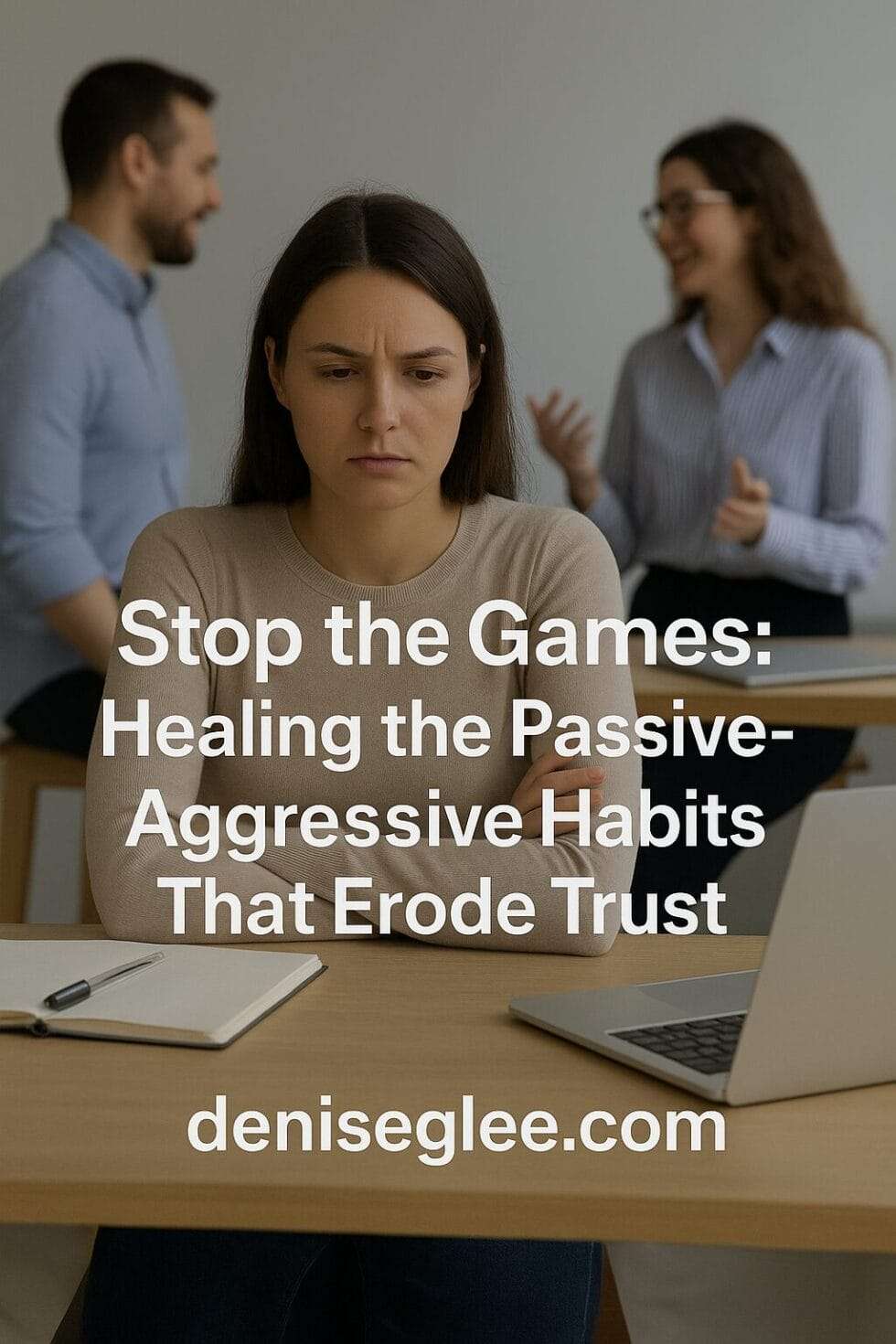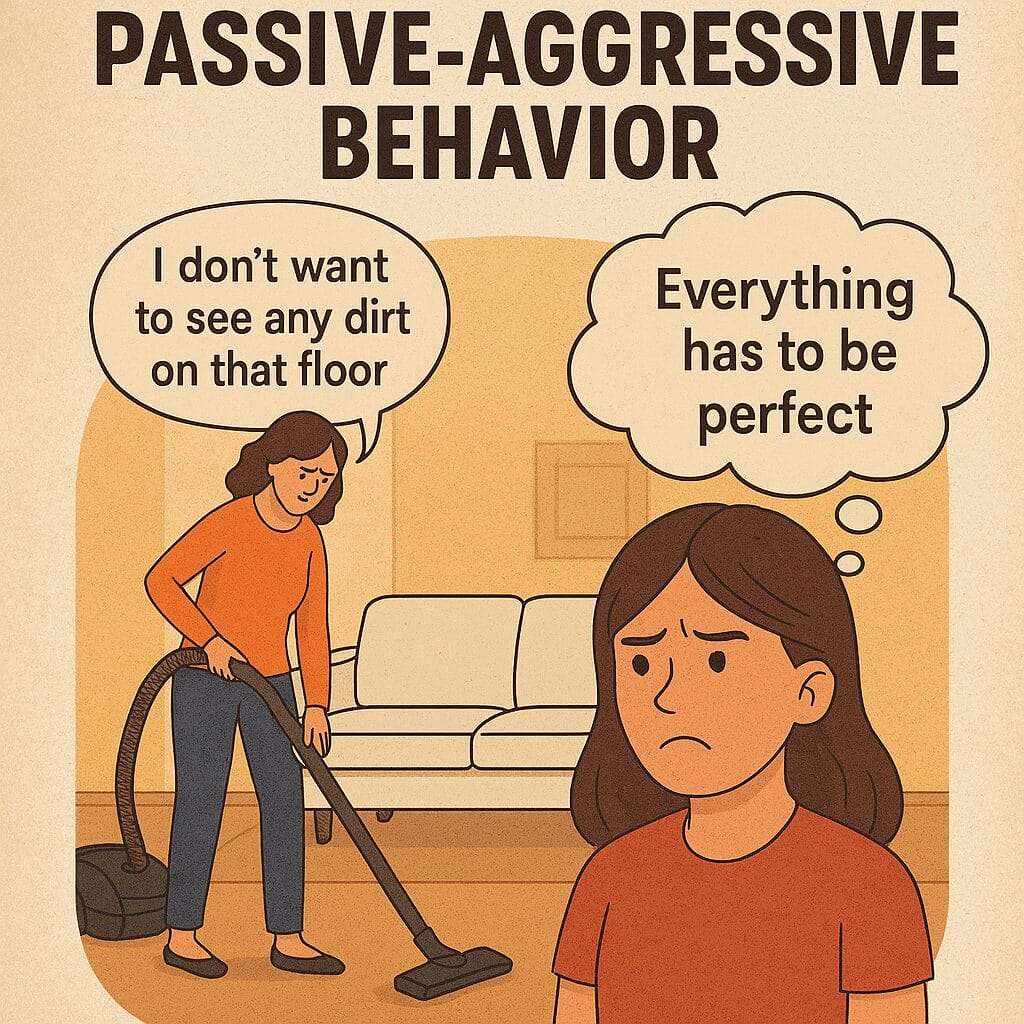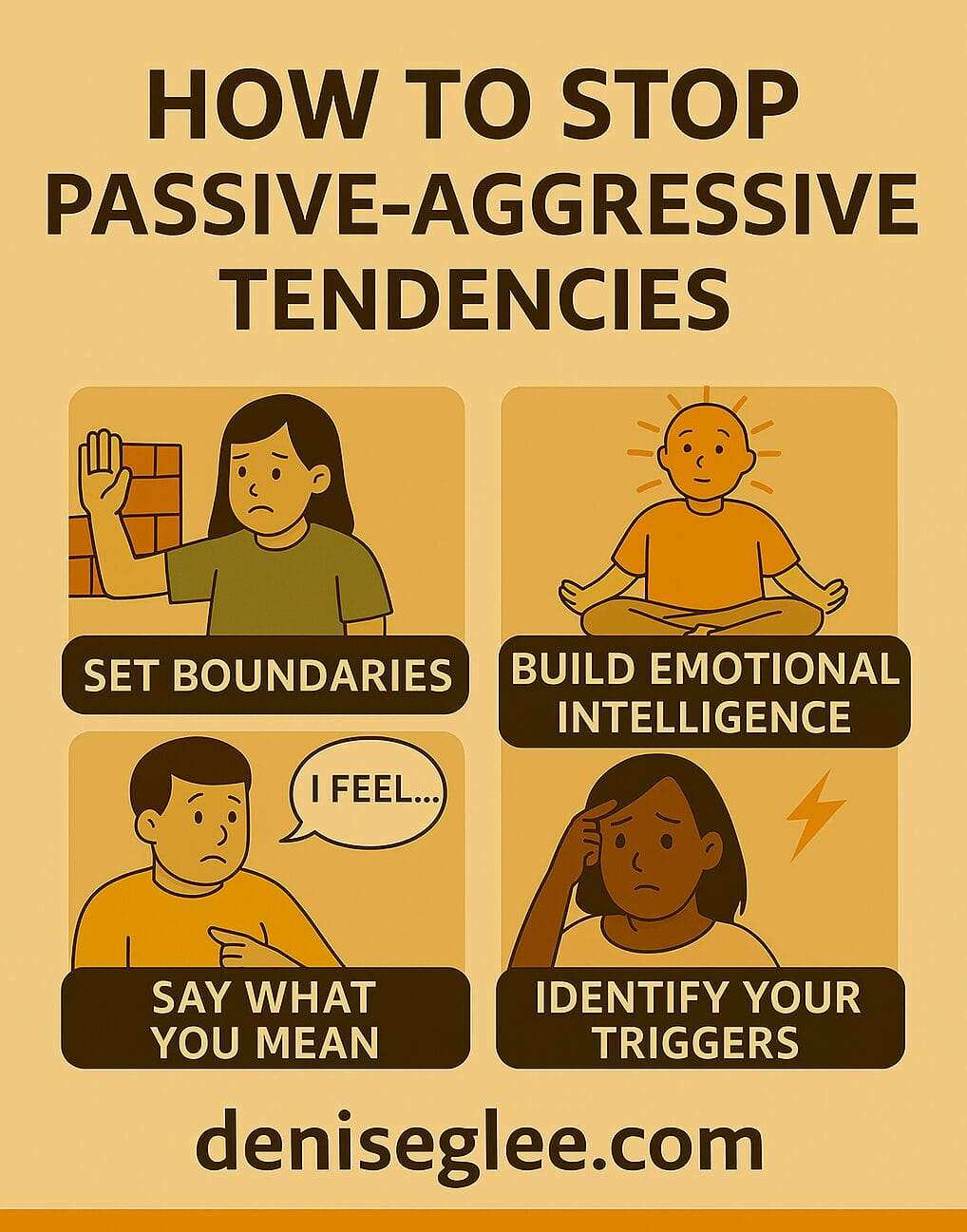
Stop the Games: Healing the Passive-Aggressive Habits That Erode Trust
- Updated: November 4, 2025
You say you’re fine. You try to keep the peace. But underneath the calm, there’s frustration you can’t quite name—and it leaks out in delays, jabs, or silence. If you’ve ever felt misunderstood, dismissed, or secretly resentful, you’re not alone. Passive-aggression isn’t who you are—it’s a defense. And it’s costing you connection. The good news? You can stop the pattern and build real trust—starting now.
As a healing and leadership coach, I care deeply about how we communicate—not just at work, but everywhere. Because how we show up in our words shapes every relationship we have.
In this post, we’ll explore where passive-aggressive habits come from and how to catch them before they sabotage your trust, your clarity, or your peace.
Roadmap to Real Change
Where Passive-Aggressive Habits Begin
Let’s be real—a lot of us were raised by folks who were insecure, scared, and doing their best with a very limited emotional toolbox. But instead of working through their fears, they managed them by trying to control, criticize, or condemn everyone around them.
I’ll never forget the days I lived with my dad and his then-girlfriend, Sandra.

“I don’t want to see any dirt on that floor!”
Sandra came from a household where perfection wasn’t optional—it was the law. Picture it: all white carpet, white furniture, white accessories. Everything had to be spotless, all the time. The pressure of keeping that pristine image wasn’t just about cleanliness—it was about fear. Fear of being seen as anything less than flawless.
You’d think she’d rebel as an adult and create a softer, freer environment. But nope. She inherited the playbook—and doubled down. That meant dragging her daughters and me into her spotless legacy.
I still remember being woken up in the middle of the night to “spot clean” the living room. Not because it was dirty—because it wasn’t perfect. We lived in a small apartment, but you’d swear it was a showroom the way she inspected every corner.
Everything had to be perfect. Or else.
Maybe you had someone like that, too—a parent or relative whose anxiety showed up as perfectionism, and whose rules were impossible to follow unless you could predict their every thought.
And here’s what often happens: when someone else gets loud, we go quiet. When they demand control, we withdraw. When they impose their version of “right,” we start resisting in silence—missed deadlines, fake smiles, the classic “sure, no problem” paired with internal rage.
These reactions don’t come from nowhere—they’re learned in childhood.
How Passive-Aggressive Parenting Still Shapes Your Leadership dives deeper into how early family dynamics hardwire you for these same resistance loops in adulthood, especially when power or authority is involved.
That’s passive-aggression. And for many of us, it became a survival tool.
Next, let’s zoom in on what passive-aggressive behavior actually looks like—and how to spot it before it turns into sabotage.
Choosing how we deal with people, even if they make us nervous, is up to us. We don't have to play games or make things messy just to handle our own fears.
Denise G. Lee Tweet
How Passive Aggression Shows Up in Everyday Life
Passive aggression comes in all sort of wonderful flavors. Here are the common signs you or someone you know is passive aggressive.
- Forget, miss, avoid overlook an important details your aggressor asked you earlier.
- Struggle to be honest with others, even when you know it is the best thing to do.
- Change your mind often and pretend there were more options when there weren’t.
- Act busy or purposely fill up your calendar in order to avoid a mean, aggressive or bossy person.
Help! I’m passive aggressive. What do I do?
Changing these habits is really tough! Not going to lie. We picked up these behaviors, along with other unhealthy ones, when we felt powerless and depended on others. They helped us at that time, but now they actually hurt us. This is what psychologists refer to as maladaptive.
We got used to being a little sneaky and avoiding people who were too pushy. Over time, this became our secret way of getting back at them. However, as we grow up, these habits don’t help us anymore. They can stop us from growing and hurt our relationships.
But things can be different when we’re getting better.
Instead of always being scared and trying to mess things up for our bossy family member or anyone else in our life, we can decide how we want to act when they’re being anxious.
We can talk about it—not just for our own feelings but for all our relationships.
Choosing how we deal with people, even if they make us nervous, is up to us. We don’t have to play games or make things messy just to handle our own fears.
We don’t need to ruin our lives just to get back at others. There’s a better way to live. In the next section, I have some tips to help you end the passive aggressive behavior.
Healing passive-aggressive tendencies is not something you can accomplish through self-study alone. Many of us are skilled in masking our past emotional pain from everyone, including ourselves.
Denise G Lee Tweet
How to Stop Being Passive-Aggressive (Even If It Feels Hard)
If you grew up around bossy or controlling people, breaking the habit of passive-aggression can feel tough. But with some effort and self-awareness, you can absolutely change! Here are some simple, practical steps to help you get started:
1. Know Yourself:
Take time to figure out when you’re being passive-aggressive. It often happens when someone is being unrelentingly critical or demanding of you, and you don’t feel safe expressing your frustration directly. In those moments, be honest with yourself.
How do you really feel? What are your ‘go-to’ strategies when you want to lash out without being accused directly of wrongdoing? Do you make sarcastic comments, give the silent treatment, or agree to things you don’t intend to follow through on? Understanding these hidden motivations and behaviors can help you address the real issues and respond in a healthier way.
I go deeper into this idea of radical self-honesty in my episode Is Your Way in the Way?—press play below when you’re ready for a real talk moment. 💛
2. Talk with a Feelings-Pro:
Healing passive-aggressive tendencies is not something you can accomplish through self-study alone. Many of us are skilled in masking our past emotional pain from everyone, including ourselves. Now is the time to speak with a therapist or a trauma-informed coach, such as myself. We know a lot about emotions and can offer you personalized advice.
3. Say What You Mean:
As I mentioned earlier, lots of people do a great job of trying to hide their feelings. At first, it was a defense strategy, now it has become a way of living our lives. However, things are different now. The next time you feel stressed or annoyed, try saying what’s on your mind directly.
Don’t be sneaky; use “I” statements to express your feelings and needs. Learn to speak up for yourself in a strong but polite way. It’s like being a superhero with words. Say “no” when you need to and set your own rules.
4. Set Some Rules:
For many of us, we allow the emotionally unsafe and controlling people around us to set all the rules. They determine what is okay or not okay to say, and we feel completely powerless around these bigger-than-life personalities. However, setting rules is not about dictating to people what they can and cannot do but rather establishing boundaries around what you will and will not tolerate.
It’s essential to communicate to others what you’re okay with and not okay with. By doing so, you can keep yourself from feeling controlled and avoid behaving in a passive-aggressive manner. Here are some more tips to help you share your feelings honestly with others.
Most people aren't trying to get you or harm you. What they are trying to do is get their needs met without consideration of others. Now you get to model to them that you can express your needs with care about others.
Denise G. Lee Tweet
5. Solve Your Problems Head-On:
Many of us bury our heads in the proverbial sand like an ostrich, thinking that if we avoid problems long enough, they will take care of themselves. Unfortunately, communication issues tend to worsen and become harder to repair when ignored. Instead of avoiding problems, confront them directly.
Keep it Focused on You
Focus on “I” rather than “you” to emphasize your feelings and desires. When discussing problems, focus on your own feelings. Say things like:
“I feel hurt when…”
“I need…”
“I would like…”
This approach is less likely to make others defensive and can lead to better conversations.
Learn to Play Better with Others
I wrote “play” rather than “work better” because, at the end of the day, you want to actually enjoy the company of others, regardless of whether it is a personal or professional situation. Learn to understand others so that you can find a mutually satisfying resolution to any problem.
This might mean:
- Compromising on some things
- Setting clear boundaries
- Finding new ways to communicate
Control feels safer than closeness—until you learn what real platonic love looks like.
Lastly, all passive-aggressive behavior is tied to unresolved emotional abuse issues. Instead of pretending that it is over, happened a long time ago, or doesn’t matter today, clearly it does matter because you are sitting here reading an article on passive aggression.
So, the first and most important thing you can do is acknowledge that crappy things happened to you by people who had crappy thoughts. Next, give yourself permission to grieve what happened, if appropriate, and distance yourself from anyone who refuses to support your emotional development. You can’t heal where you got sick.
6. Think Like Others:
When someone tries to control others, it may seem strange or unreasonable. But it’s important to see things from their point of view. Often, they’re afraid or worried about something, and trying to control things makes them feel better.
Instead of thinking of them as mean, it’s better to understand that they’re just struggling to cope. By seeing them this way, you can be kinder and more straightforward when dealing with them, instead of being sneaky or unkind.
7. Keep Calm:

Try to stay calm and relaxed. And when I say calm, I mean giving yourself the space to realize that even when you feel upset, afraid, or scared — this experience is teaching you more about yourself than you may ever realize.
This is a shift in your mindset. It helps you see the bigger picture — not just about you, but the world around you. When you make this shift, you start to notice how behaviors like barbed humor, avoidance, or sulking only keep you stuck. Barbed humor might look like making sarcastic or cutting jokes when you’re really feeling hurt. Sulking often shows up as withdrawing, being silent, or giving off an attitude of resentment without saying what’s really bothering you. These behaviors stop you from actively and appropriately responding to your feelings of discomfort.
Remember, not everyone is trying to hurt us or make life difficult. When we take a moment to relax and let go of stress, we give ourselves the chance to respond with clarity and grace. This helps us avoid slipping into passive-aggressive behavior during tough situations.
8. Hang Out with Kind and Considerate People:
Being around mean and critical people can make us see life in a negative way and hurt our conversations. We start thinking, “Well, if that’s how people act, then I have to act that way to survive.” But I’m here to tell you — you don’t have to match or mirror that kind of behavior. In fact, this is one of the things successful people avoid.
Instead, we challenge ourselves to want better in every area of life — and that includes the people we choose to spend our time with. When we spend time with people who speak with kindness and treat others with respect, we feel less stressed. We start to see things more clearly and handle tough situations without trying to control everything. Their calm and positive approach helps us grow and become better versions of ourselves.
9. Keep Learning:
Reading this article or anything else from my blog cannot be the end of your healing journey, and it mustn’t be. Successful people keep learning and growing. Take some time to read more about being honest with your feelings. You can take one of my courses and learn to be more intelligent about how you relate to others and yourself. Learning more will help you improve.
Remember, it takes time to change, so be kind to yourself as you try to stop being passive-aggressive, and congratulate yourself when you do something good.
The picture below summarizes my top tips. In the following section, I will share my final thoughts.

Healing the Deeper Triggers Behind Passive-Aggressive Habits
Next Steps: Rebuilding Trust and Emotional Safety
Unlearning passive-aggression isn’t about shame—it’s about choosing honesty over hidden frustration. It takes time. It takes courage. But every small moment of clarity, every time you pause and choose truth instead of silence—that matters.
If this hit home, I’d love to hear from you.
👉 Write me a note
Want to go deeper?
🎧 Listen to this related podcast episode where I unpack why passive-aggression shows up and how to stop letting it quietly sabotage your relationships.
And if you’re ready to break the pattern for good?
💛 Work with me, Denise G. Lee – Together, we’ll untangle the deeper patterns behind your behavior and rebuild trust from the inside out.
You’re not too broken. You’re just ready to grow. Let’s begin.





